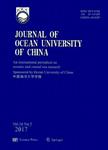Arsenic Removal from Pinctada martensii Enzymatic Hydrolysate by Using Zr(Ⅳ)-Loaded Chelating Resin
Arsenic Removal from Pinctada martensii Enzymatic Hydrolysate by Using Zr(Ⅳ)-Loaded Chelating Resin作者机构:Yantai Institute of Coastal Zone ResearchChinese Academy of Sciences South China Sea Institute of OceanologyChinese Academy of SciencesCAS Key Laboratory of Marine Bio-Resourses Sustainable Utilization University of Chinese Academy of Sciences
出 版 物:《Journal of Ocean University of China》 (中国海洋大学学报(英文版))
年 卷 期:2013年第12卷第3期
页 面:392-396页
核心收录:
学科分类:083002[工学-环境工程] 0830[工学-环境科学与工程(可授工学、理学、农学学位)] 082803[工学-农业生物环境与能源工程] 08[工学] 0828[工学-农业工程] 09[农学] 0903[农学-农业资源与环境]
基 金:supported by National Key Technologies R&D Program of China(2008 BAD94B08)
主 题:Pinctada martensii enzymolysis arsenic removal chelating resin
摘 要:The present study investigated the removal of inorganic arsenic from Pinctada martensii enzymatic hydrolysate through unmodified resin (D296) and Zr(IV)-loaded chelating resin (Zr-D401). By loading Zr to macroporous chelating resin D401, the as exchange adsorption active sites are generated. This transforms D401 from a material that does not have the arsenic adsorption capacity into a material that has excellent arsenic exchange adsorption capacity. The static adsorption experiments were conducted to investigate the optimal removal condition for D296 and Zr-D401. The experimental results show that: the optimum condition for D296 is that T= 25℃, pH= 5, resin additive amount= 1 g (50 mL)-1, and contact time = 10 h, the corresponding arsenic removal rate being 65.7%, and protein loss being 2.33%; the optimum condition for Zr-D401 is that T=25 ℃, pH = 8, resin additive amount= 1 g (50 mL)-1, and contact time=10 h, the corresponding arsenic removal rate being 70.3%, and protein loss being 4.65%. These results show that both of the two resins are effective in arsenic removal for preserving useful substance. Our research provides scientific evidence and advances in the processing technology for heavy metal removal in shellfish.



